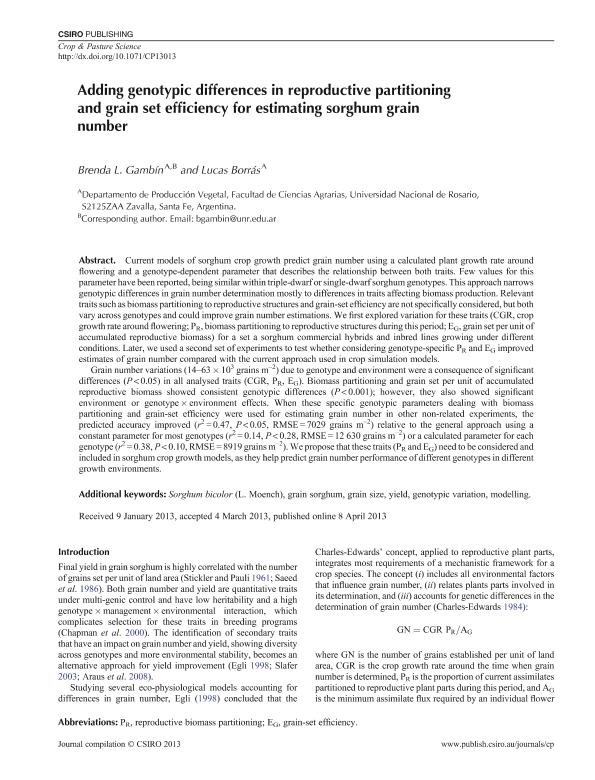Mostrar el registro sencillo del ítem
dc.contributor.author
Gambin, Brenda Laura

dc.contributor.author
Borras, Lucas

dc.date.available
2017-07-28T20:24:27Z
dc.date.issued
2013-04
dc.identifier.citation
Gambin, Brenda Laura; Borras, Lucas; Adding genotypic differences in reproductive partitioning and grain set efficiency for estimating sorghum grain number; Csiro Publishing; Crop and Pasture Science; 64; 1; 4-2013; 9-17
dc.identifier.issn
1836-0947
dc.identifier.uri
http://hdl.handle.net/11336/21591
dc.description.abstract
Current models of sorghum crop growth predict grain number using a calculated plant growth rate around flowering and a genotype-dependent parameter that describes the relationship between both traits. Few values for this parameter have been reported, being similar within triple-dwarf or single-dwarf sorghum genotypes. This approach narrows genotypic differences in grain number determination mostly to differences in traits affecting biomass production. Relevant traits such as biomass partitioning to reproductive structures and grain-set efficiency are not specifically considered, but both vary across genotypes and could improve grain number estimations. We first explored variation for these traits (CGR, crop growth rate around flowering; PR, biomass partitioning to reproductive structures during this period; EG, grain set per unit of accumulated reproductive biomass) for a set a sorghum commercial hybrids and inbred lines growing under different conditions. Later, we used a second set of experiments to test whether considering genotype-specific PR and EG improved estimates of grain number compared with the current approach used in crop simulation models. Grain number variations (14–63 103 grains m–2 ) due to genotype and environment were a consequence of significant differences (P < 0.05) in all analysed traits (CGR, PR, EG). Biomass partitioning and grain set per unit of accumulated reproductive biomass showed consistent genotypic differences (P < 0.001); however, they also showed significant environment or genotype environment effects. When these specific genotypic parameters dealing with biomass partitioning and grain-set efficiency were used for estimating grain number in other non-related experiments, the predicted accuracy improved (r 2 = 0.47, P < 0.05, RMSE = 7029 grains m–2 ) relative to the general approach using a constant parameter for most genotypes (r 2 = 0.14, P < 0.28, RMSE = 12 630 grains m–2 ) or a calculated parameter for each genotype (r 2 = 0.38, P < 0.10, RMSE = 8919 grains m–2 ). We propose that these traits (PR and EG) need to be considered and included in sorghum crop growth models, as they help predict grain number performance of different genotypes in different growth environments.
dc.format
application/pdf
dc.language.iso
eng
dc.publisher
Csiro Publishing

dc.rights
info:eu-repo/semantics/openAccess
dc.rights.uri
https://creativecommons.org/licenses/by-nc-sa/2.5/ar/
dc.subject
Sorghum
dc.subject
Grain Number
dc.subject
Grain Size
dc.subject
Modelling
dc.subject.classification
Agricultura

dc.subject.classification
Agricultura, Silvicultura y Pesca

dc.subject.classification
CIENCIAS AGRÍCOLAS

dc.title
Adding genotypic differences in reproductive partitioning and grain set efficiency for estimating sorghum grain number
dc.type
info:eu-repo/semantics/article
dc.type
info:ar-repo/semantics/artículo
dc.type
info:eu-repo/semantics/publishedVersion
dc.date.updated
2017-07-28T18:02:29Z
dc.journal.volume
64
dc.journal.number
1
dc.journal.pagination
9-17
dc.journal.pais
Australia

dc.description.fil
Fil: Gambin, Brenda Laura. Universidad Nacional de Rosario. Facultad de Ciencias Agrarias; Argentina. Consejo Nacional de Investigaciones Científicas y Técnicas; Argentina
dc.description.fil
Fil: Borras, Lucas. Universidad Nacional de Rosario. Facultad de Ciencias Agrarias; Argentina. Consejo Nacional de Investigaciones Científicas y Técnicas; Argentina
dc.journal.title
Crop and Pasture Science
dc.relation.alternativeid
info:eu-repo/semantics/altIdentifier/doi/http://dx.doi.org/10.1071/CP13013
dc.relation.alternativeid
info:eu-repo/semantics/altIdentifier/url/http://www.publish.csiro.au/cp/CP13013
Archivos asociados
